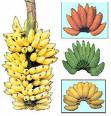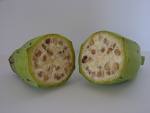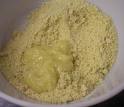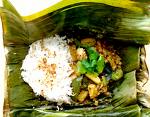
The Biology of the Banana


The banana, also known as a plantain, is giant herbaceous plant native to the South Pacific. The plant itself has a rather confusing taxonomical hierarchy. In general, “banana” is the name given to those plants that produce a sweeter form of fruit, one that is often consumed uncooked, such as the “desert bananas” that make up most of the fruits consumed in the United States or in Europe. In contrast, the “plantain” often refers to a starchier fruits that are often cooked before eating. Plantains form the bulk of the bananas that are consumed as staple crops. For the purposes of this essay, there is no distinction made between banana and plantain, unless otherwise noted. There are about fifty recognized species of banana, all under the genus Musa, but given the long history of banana hybridization, and the creation of plants with two or three sets of chromosomes (diploid and triploid), it can be difficult for the casual observer to distinguish between banana varieties. Perhaps the easiest classification of the fruit involves differentiating between those species that are domesticated and those that are wild.
Wild-type bananas are found throughout Southeast Asia, but are mostly inedible to humans. With hard seeds studding the fruit, wild-types have little fruit that is eatable, rendering the wild-types relatively useless for their fruit. Occasionally, however, wild-type bananas produced mutant offspring, which bore seedless fruits. Seedless mutants became the ancestors of domesticated bananas when early humans specially bred the fruit through root offshoots, or “suckers,” which appear at the base of the plants. Humans reproduced bananas from the suckers “vegetatively,” that is, by separating the offshoot from the mother pseudostem, and then replanting the suckers as a separate plant. Thus, the propagation of domestic bananas formed genetically identical plants, all of the edible, seedless variety.
The fruit, upon developing, forms an individual banana known as a “finger.” Fingers grow in groups as many as twenty, known as “hands,” and large groups of hands form a “bunch” or a “banana stem.” Each finger contains an edible pulp surrounded by an epidermis that serves as protection for the fruit. The epidermis, or “peel,” is also edible; ripened desert bananas are often peeled and eaten raw, while plantains and unripened bananas are sometimes cooked and consumed peel and all. The peel serves as a self-storage facility for the fruit, and the inner pulp is often edible even if the outer peel has been contaminated by the environment. Though the fruit is thus protected from undesirable elements outside of the peel, the plant itself is quite vulnerable to disease.
Plantain farmers must keep a continuous replanting cycle to ensure stable crop yields. Replanting of suckers after a series of fruiting cycles is important, as disease often builds up over a period of years and greatly diminishes the amount of fruit produced by the plant. Given the lack of genetic variety among domesticated bananas, the plants are especially susceptible to various diseases, including Panama Disease, Black Stigatoka, and Banana Bunchy Top Virus, among many others. Such diseases, when contracted, can be devastating to individual plants as well as whole banana plantations. Indeed, the Gros Michel banana became commercially extinct by the 1950s as a result of its destruction by Panama Disease.
Domestic bananas offered a major nutritive advantage for early cultivators. As a non-seasonal crop, bananas were available year long, and became a staple food for many tropical cultures. Bananas and plantains provide a main source of calories to people in Africa, Asia, the Pacific Islands, and South and Central America. Though it varies with types, a banana that has been cooked is roughly equivalent calorically and nutritionally to a potato. Bananas are rich sources of both simple and complex carbohydrates, and of the vitamins ascorbic acid, B6, carotene, niacin, riboflavin, and thiamin. They are also excellent sources of potassium. Moreover, bananas are easily digestible, offering access to food energy faster than apples, milk, oranges, and meats. Though they are poor sources of protein and fat, and thus must be part of a supplemented diet, as a staple food, bananas have been the main foodstuff of millions of people for thousands of years.
In addition to providing a staple crop for millions of people, by the mid-nineteenth century, bananas developed into an important cash and variety crop for Americans and Europeans. Desert bananas are among the most popularly consumed fruit in both the United States and Europe, so much so that they have become one of the most important agricultural items in global commerce, perhaps second in importance only to coffee. Though banana exports account for only 15% of global plantain production, the economies of many Central American, South American, and Caribbean nations are heavily reliant upon desert banana production and trade to the West.
Banana consumption is not limited to fruit. Bananas, or their derivatives, are also the source of other foodstuffs, including banana flour, banana chips, and, in some areas, banana beer. The heart of the banana plant can also be harvested for certain dishes, or be juiced for its liquid. Beyond food, banana leaves provide important household materials, either freshly harvested or dried. Fresh banana leaves serve as plates or, when wrapped, containers for cooking. When dried, the fronds are woven into roofing materials or other fabrics. Since the 1200s, fibers from the banana plant have been used by Japanese to create fabrics for textiles, including clothing. Bananas can also be used in paper production. Finally, banana plants are also becoming more popular in regional gardens, adding variety of an ornamental nature to some home plots.
Plantains are consumed not only for their material value, but also for their cultural significance. Bananas serve as sources of popular culture, including religious traditions, musical inspiration or allusion, and as symbols of sex, race, and class. The historical importance of bananas to culture is continuously being rediscovered, as in the case of the banana’s role in the academic disciplines of archeology and history. Indeed, contemporary techniques for archeological exploration are being developed around the physical and historical properties of the banana. Fossilized banana silica, known as phytoliths, are used by present-day archeologists and historians to “date” and determine the presence of the ancient human societies of Polynesia and Southeast Asia. Thus, the banana’s cultural and material significance have become fused in current archeological investigations. Similarly, the banana’s material importance has fueled research in agro-ecology, plant biology, plant pathology, and economics, stimulating both academic and professional studies. Clearly, the banana is of a unique, ubiquitous importance in both a historical and present-day explorations of commodities.
Bibliography:
Banana; accessed on 10 June 2008.
De Langhe, Edmund. “Banana and Plantain: the Earliest Fruit Crops?” Montpellier:
International Network for the Improvement of Banana and Plantain, Focus Paper
1. INIBAP Annual Report 1995, 6-8.
Heslop-Harrison, J.H. and Trude Schwarzacher. “Domestication, Genomics, and the
Future for Banana,” Annals of Botany 100, no. 5 (2007): 1073-1084.
Kennedy, Jean. “Pacific Bananas: Complex Origins, Multiple Dispersals? ” Asian
Perspectives 47, no. 1 (2008): 75-94.
Langdon, Robert. “The Banana as a Key to Early American and Polynesian History.”
The Journal of Pacific History 28, no. 1 (1993): 15-35.
Miles, Tim. “Yes, We Have More Bananas.” The Garden 127, no. 5 (May 2002):
357-361.
“Musa (genus).” Musa (genus) - Wikipedia, the Free Encyclopedia. http://
en.wikipedia.org/wiki/Musa_%28genus%29; accessed on 10 June 2008.
Sharrock, Suzanne and Emile Frison. Musa Production Around the World – Trends,
Varieties and Regional Importance. Montpellier: International Network for the
Improvement of Banana and Plantain, Focus Paper 2. INIBAP Annual Report
1998, 42-47.
Soluri, John. “Banana Cultures: Linking the Production and Consumption of Export
Bananas, 1800-1980.” In Banana Wars: Power Production and History in the
Americas, ed. Steve Strffler and Mark Morberg, 48-79. Durham and London:
Duke University Press, 2003.
Vrydaghs, L. and Edmund De Langhe. Phytoliths: An Opportunity to Rewrite History?
Montpellier: International Network for the Improvement of Banana and Plantain,
Focus Paper 1. INIBAP Annual Report 2002, 14-17.

The Biology of the Banana







